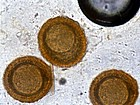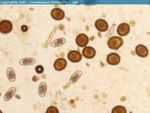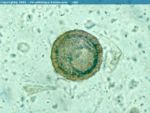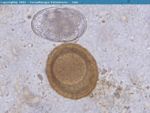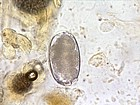Category:Horse Nematodes
Jump to navigation
Jump to search
Gastrointestinal Nematodes
Introduction
Many nematode species occur in the equine gastrointestinal tract, although not all are of equal importance:
| Stomach | Small Intestine | Large Intestine |
|---|---|---|
|
|
|
Strongyles (Red worms)
The strongyles that occur in the horse can be divided on the basis of size into two groups
- Large strongyles
- Strongylus species (3 species; used to be widespread prior to the introduction of worm control programmes; now uncommon)
- Triodontophorus species (common)
- Small strongyles
- Also known as Cyathostomins (preferred term), cyathostomes, trichonemes or small redworms
- Cyathostomins (widespread, including 4 genera and over 40 species of worms)
Large strongyles
Morphology
Gross
- Stout worms, 1.5-5cm long
- Large buccal capsule
- Bursa visible to the naked eye (male worms only)
Microscopic (buccal capsule)
- Double row of leaf crowns
- Teeth (0, 2, 3 or more)
- Dorsal gutter (channel for secretions)
Life-cycle
Infection with all three Strongylus species and Triodontophorus is by ingestion of infective stage larvae (L3) at grazing. Larvae pass down the intestinal tract and penetrate the intestinal mucosa at which point there are important species differences in life-cycle.
Pathogenicity
Adult Worms:
- Plug feeders
- Strongylus species:
- Large buccal capsule
- Penetrate right down to the muscularis layer and blood vessels
- Leaves small circular bleeding ulcers → anaemia if present in large numbers
- Triodontophorus:
- Smaller buccal capsule
- More superficial damage
- May feed in "herds", leaving large ulcers, several centimetres across
- Ulcers heal and leave scars
Pages in category "Horse Nematodes"
The following 16 pages are in this category, out of 16 total.
